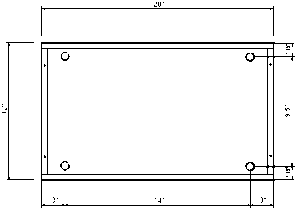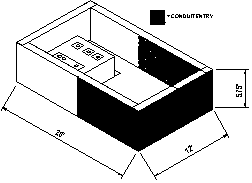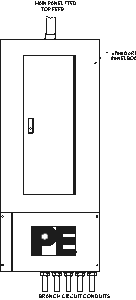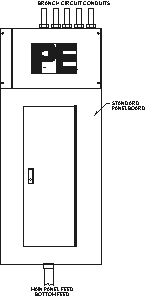EGPE Electronic Grade Panelboard®
Extension Suppression Filter System
Installation, Operation and Maintenance Instructions
Current Technology, Inc.
3001 W. Story Rd.
Irving, TX 75038 USA
Telephone: (972) 252-4400
Toll-Free: (800) 238-5000
Facsimile: (972) 252-7705
“24×7” Technical Service Hotline: (888) 200-6000
INTRODUCTION TO EGPE PRODUCTS INSTALLATION
Congratulations on joining the extensive list of satisfied Current Technology customers. Since our inception in 1971, thousands of our electrical transient suppression filter systems have been installed to protect critical loads in a wide variety of industries.
The success of Current Technology products is a result of more than two decades of focused lab and field research resulting in a unique and exclusive approach to power quality. Our patented suppression filter systems provide all modes of bi-directional surge suppression and electrical line noise filtering with a revolutionary engineering design called seamless technology .
Seamless technology utilizes the individual performance capabilities of up to four major components — selenium cells (Plus products), carbon thin film high energy capacitors, non-linear voltage dependent metal oxide varistors (MOVs) and synergistic component geometry — to deliver “seamless” power without damaging surges or electrical high frequency noise which causes damage or “lock-up” of sensitive modern electronic devices.
The Electronic Grade Panelboard® Extension (EGPE) provides surge suppression and electrical high frequency noise filtering for existing for panelboards. The EGPE will provide protection from surges and electrical high frequency noise generated on the line side of panelboard and load generated surges and electrical high frequency noise generated by loads being fed from the panelboard. EGPE is designed to mount above or below Square D, GE, Cutler-Hammer/Westinghouse and Siemens lighting panelboards for easy installation of surge suppression and electrical high frequency noise filtering.
To maximize performance from your Current Technology suppression filter system, strategic location is as important as correct wiring methods. Proper physical location will enable your unit to provide the industry’s most reliable transient and noise protection. Your Current Technology suppression filter system should be installed in a location minimizing wire lengths and wiring bends. This positioning maximizes both surge suppression and filtering, while providing added protection for the protected loads. Please contact our field service department at (800) 238-5000 or our “24 x 7” technical Hotline at (888) 200-6000 to obtain installation assistance.
Today’s sophisticated electronic equipment requires the best suppression filter systems possible. By selecting Current Technology products, you have taken a critical step toward decreasing downtime and ensuring longer product life for your equipment. We look forward to fulfilling your suppression filter system needs.
PRIOR TO INSTALLATION
THE FOLLOWING IS INTENDED FOR QUALIFIED ELECTRICAL PERSONNEL ONLY. READ COMPLETE INSTALLATION INSTRUCTIONS BEFORE BEGINNING INSTALLATION. CALL CURRENT TECHNOLOGY WITH ANY QUESTIONS. IT IS THE FINAL RESPONSIBILITY OF THE INSTALLING ELECTRICIAN TO ENSURE THAT ALL LOCAL CODES AND OTHER APPLICABLE SAFETY/ENVIRONMENTAL CONDITIONS ARE MET AND THE UNIT IS CORRECTLY INSTALLED.
EGPE Product Enclosure Type: NEMA 1 Metallic Environment: All units should be installed in a safe protected area with ambient temperature between -40oC to +60oC (-40oF to +140oF).
Humidity should be 5-95% non-condensing relative humidity.
INSTALLATION
Current Technology EGPE products must be installed in parallel to facilities’ electrical distribution system via circuit breakers for overcurrent protection.
1. Voltage Verification: Prior to product installation, verify that the voltage rating of the intended electrical distribution system matches the voltage rating of the unit to be installed. Warning: serious injury or damage may result from installing a product with an improper voltage rating. Contact factory if voltage ratings are not identical. FOR WYE-CONNECTED SYSTEMS, CHECK NEUTRAL GROUND BOND AT TRANSFORMER PROVIDING POWER TO PROTECTED LOADS. WARRANTY VOID IF EGPE PRODUCT IS CONNECTED TO INCORRECT VOLTAGE CONFIGURATION OR IF NEUTRAL-GROUND BOND IS NOT PRESENT IN WYE-CONFIGURED SYSTEMS. CAUTION: HIGH LEG DELTA-CONFIGURED EGPE PRODUCTS MUST BE SUPPLIED FOR HIGH LEG DELTA VOLTGE CONFIGURATIONS (B LEG MUST BE THE HIGH LEG FOR THESE CONFIGURATIONS). WARRANTY VOID IF THIS IS NOT THE CASE.
2. Installation Location:
To minimize installed system impedance, mount Current Technology EGPE unit in a location that minimizes electrical wire bends and wiring distance from point of connection. Typically, EGPE is installed above or below standard panelboard.
3. Mounting:
Utilizing the mounting feet and hardware supplied with the unit, mount EGPE unit securely to building surface or structural member (refer to mounting templates below shown in Figure 1).

Figure 1: Mounting Template for EGPE100 and EGPE65
4. Conduit Hole Location:
Punch conduit holes for conduit connectors in gray shaded areas as shown in Figure 2 to ensure that external wiring will not interfere with internal components or require excessively sharp bends. Pull wire as necessary. For panelboards with top-entry main power feed, mount EGPE to the bottom of the panelboard with suppression module oriented on left-side of EGPE (refer to Figure 3). For panelboard with bottom-entry main power feed, mount EGPE to the top of the panelboard with suppression module oriented on right-side of EGPE (refer to Figure 4).

Figure 2: Conduit Entry for EGPE100 and EGPE65

Figure 3: Panelboard plus EGPE installation for Top-entry of Main Power Feed

5. Electrical Connection:
EGPE units must be installed in parallel with the electrical distribution system via a three pole 15 amp breaker or three single pole 15A breakers for three phase installations (a two pole 15A breaker or two single pole 15A breakers should be used for 120/240V split phase panelboards). For best results, locate these breakers as close as possible to EGPE. For top entry of power feed into panelboard with EGPE mounted to the bottom of the panelboard, use bottom right breaker positions to feed EGPE. For bottom entry of power feed into panelboard with EGPE mounted to the top of the panelboard, use top left breaker positions to feed EGPE. Use recommended copper conductor for parallel phase conductor connections (A, B and C terminals) and neutral (N) and ground (G) conductors. Recommended wire sizes for all connections is shown in Table 2. Tighten lugs to maximum torque levels shown in Table 3. Refer to Figure 5 for EGPE layout.
| Model | Phase Conductor Wire Size | Neutral Conductor Wire Size | Ground Conductor Wire Size |
| EGPE100 and EGPE65 | #8 AWG Copper | #2-1/0 AWG Copper | #2-1/0 AWG Copper |
Table 2: Recommended Wire Sizes
| Model | Torque Values for Units with Fuse Block (A, B, C) (in-lb.) |
Torque Values Neutral (in-lb.) |
Torque Value for Ground (in-lb.) |
| EGPE100 and EGPE65 | N/A | 52 | 52 |
Table 3: Recommended Maximum Torque Values
Internal View External View

7. Options
A. Remote Monitor Contacts Option
All EGPE models are available with two sets of form C remote monitor dry contacts that may be connected to building management systems or remote annunciation alarm panels. To wire contacts, locate the output terminals mounted on the dry contact circuit board. Each set of contacts may be wired independently. Each set of form C remote monitor dry contacts include common (C), normally open (NO) and normally closed (NC) contacts. For normally open operation under energized conditions, connect the normally open terminal and common terminal to the monitoring input. For normally closed operation during energized conditions, connect the normally closed terminal and common terminal to the monitoring input. Upon loss of power to any or all phases, contacts will change to alarm state.
B. StatusWatch Option
EGPE models are available with StatusWatch diagnostic monitoring. StatusWatch includes battery powered audible alarm with test and disable functions, two sets of form C remote monitor dry contacts and optional disturbance counters. Battery is a field replaceable standard 9V alkaline. To activate battery, remove isolation strip between battery and terminal and push battery firmly into battery holder terminals.
To test audible alarm, press alarm test push-button: alarm should sound and alarm/test indicator should flash. Alarm may be silenced by moving toggle switch into upper position; alarm disable indicator will illuminate.
To wire dry contacts, locate output terminals mounted on Form C contact board. Each set of contacts may be wired independently. For normally open operation under energized conditions, connect the normally open terminal and common terminal to the monitoring input. For normally closed operation during energized conditions, connect the normally closed terminal and common terminal to the monitoring input. Upon loss of power to any or all phases, contacts will change to alarm state.
StatusWatch is available with dual disturbance counter(s) that measure the number of Line-to-Neutral and Line-to-Ground transients occurring in WYE configurations. For DELTA systems, a single counter measures Line-to-Line transients. To reset counters, remove connector on the back of each counter and short pins 1 and 3.
8. Electrical Field Checks
Before applying power to the unit, perform the following electrical field tests. Voltages must be measured with a true RMS voltmeter (i.e., Fluke 87):
o Line-to-Line voltage may not exceed +10% of the rated nominal voltage for the unit. The unit’s rated nominal voltage may be found on the label inside the unit door or in Table 4.
o Line-to-Neutral voltage may not exceed +10% of the rated nominal voltage for the unit. The unit’s rated nominal voltage may be found on the label inside the unit door or in Table 4.
o Line-to-Ground voltage may not exceed +10% of the rated voltage for the unit as called out in Table 4.
o Neutral-to-Ground voltage may not exceed the rated voltage for the unit as called out in Table 4.
CAUTION!!
VOLTAGE READINGS OTHER THAN THOSE LISTED ABOVE AS ACCEPTABLE WILL DAMAGE THE UNIT AND VOID THE WARRANTY. IF YOU HAVE QUESTIONS REGARDING VOLTAGES OR WIRING, PLEASE CALL CURRENT TECHNOLOGY.
9. Final Instructions
If all voltages are in tolerance, replace the cover of the unit and tighten fastening screws. Apply power to the unit by engaging the appropriate fused disconnect switch or circuit breaker. Illumination of status lights indicates proper function.
10. DTS-2 Test Point
Disconnect connector running from the suppression filter system to status lights before testing the unit with the optional DTS-2 Diagnostic Test Set. Follow instructions contained with the DTS-2 Test Set for proper testing procedure.
OPERATION
1. The EGPE suppression filter system is now operational. Current Technology suppression filter systems are designed to operate indefinitely without any component failures or routine parts replacement.
2. To disengage unit and remove protection from the electrical system, either turn off external power by disengaging the circuit breaker or external fused disconnect switch feeding power to the unit; or, for units with integral fused disconnect switch, turn switch to “OFF” position.
3. Should verification and test of unit operation be necessary, the integral test point installed in each Current Technology unit allows connection of Current Technology’s portable DTS-2 Diagnostic Test Set to test total unit function. See Maintenance Section and DTS-2 product literature for further information.
MAINTENANCE
Your Current Technology EGPE suppression filter system does not require periodic maintenance. The unit’s heavy-duty design should preclude the need for any repairs; however, the following indicators may signal the need for fuse or indicator light replacement and/or unit testing:
| INDICATION | PROCEDURE |
| One or more phase indicator lights are off. |
1. Check that the external power source supplying power to unit is energized. 3. Check connector connecting indicator lights to suppression module. 4. If all of above are O.K., contact factory. 5. If external circuit breaker is tripped, use DTS-2 portable diagnostic test set to verify unit integrity before fuse replacement and/or breaker reclosing. |
| Portable Diagnostic Test Set (Current Technology Model DTS-2) indications | Refer to Diagnostic Test Set manual for procedures and explanations. |
TABLE 4 : NOMINAL VOLTAGES
| MODEL | VOLTAGE | CONFIGURATION | NOMINAL VOLTAGES | |||
| SUFFIX | L-L | L-N | L-G | N-G | ||
| 120/240-2G | 120/240 | GROUNDED NEUTRAL | 240 | 120 | 120 | 0 – 5 |
| 120/208-3GY | 120/208 | GROUNDED WYE | 208 | 120 | 120 | 0 – 5 |
| 277/480-3GY | 277/480 | GROUNDED WYE | 480 | 277 | 277 | 0 – 5 |
| 120/240-3GHD | 120/240 X 208 | GROUNDED NEUTRAL “HIGH-LEG” DELTA | 240 | A&C: 120 B: 208 |
A&C: 120 B: 208 |
0 – 5 |
| 220/380-3GY | 220/380 | GROUNDED WYE | 380 | 220 | 220 | 220 |
| 347/600-3GY | 347/600 | GROUNDED WYE | 600 | 347 | 347 | 347 |
| 240-3UD | 240 | UNGROUNDED DELTA | 240 | |||
| 480-3UD | 480 | UNGROUNDED DELTA | 480 | |||
| 600-3UD | 600 | UNGROUNDED DELTA | 600 | |||
NOTE: All line voltages should be within +/- 10% of rated nominal voltage.
NOTE: For DELTA systems, phase-to-ground voltages is either 1) The rated phase-to-phase voltage or 2) Zero (0) for the “grounded” phase.
NOTE: Neutral-Ground voltages should be below 5V for a WYE system. No neutral in DELTA systems.
FIVE YEAR LIMITED WARRANTY
Current Technology EGPE products are warranted for five years.
LEGAL NOTICE
Current Technology products are protected by patents which may be issued after the publication of this document as well as by one or more of the following patents: 5,023,746; 4,835,650; 4,675,538; 4,675.772; 5,191,502; 4,860,502; 4,127,888; 5,146,357; 4,794,490; 5,257,157. All rights reserved. Current Technology will enforce and protect its patent rights as provided by Section 35 USC and a $500,000 litigation protection insurance policy.
